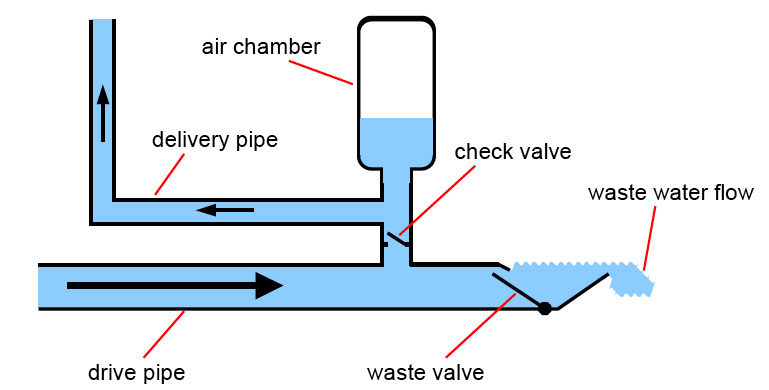Difference between revisions of "Hydraulic Ram pump"
From Akvopedia
| Line 11: | Line 11: | ||
<b>Hydraulic Ram pumps</b> | <b>Hydraulic Ram pumps</b> | ||
| − | |||
| − | |||
| − | |||
| − | |||
| − | |||
| − | |||
| − | |||
| − | |||
| − | |||
| − | |||
| + | {{procontable | pro= | ||
| + | - Uses renewable energy sources. <br> | ||
| + | - If properly designed, can be produced and maintained locally. <br> | ||
| + | - Very effective in mountaneous areas<br> | ||
| + | | con= | ||
| + | - Water with height difference is needed<br> | ||
| + | }} | ||
== Capacity == | == Capacity == | ||
Revision as of 15:03, 29 April 2009
| |
A hydraulic ram pump is a water pump powered by water. In areas where natural flows exist with a height difference of the water over a small distance, hydraulic ram pumps can be used to transport water to higher grounds without using electricity or fuel, by using the energy in the speed of the flow to pump a portion of the water up to a much higher level.
Hydraulic Ram pumps
| Advantages | Disadvantages/limitations |
|---|---|
| - Uses renewable energy sources. - If properly designed, can be produced and maintained locally. |
- Water with height difference is needed |
Contents
Capacity
Costs
Additional opportunities
Movies
- Local Hydraulic Ram pump produced by AID Foundation, Philippines
- Installation of Hydraulic Ram pumps in Afghanistan by AID Foundation, Philippines
- Ram pump produced by R.A. Initiatives, Philippines

Click here to see how you can contribute pictures
|
External links
- | General explanation on wikipedia
- | Article on the AID Foundation hydraulic ram, winner of the Ashden Award in 2007
- | Several in-depth articles on the function and construction of hydraulic rams, including detailed drawings of a low-cost and tested design. Development Technology Unit (DTU), University of Warwick, UK
- | Low cost self made pump
- | another low tech pump design



